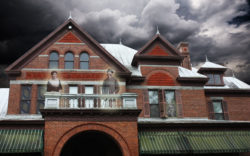Sometimes, when somebody had a good thing, they don’t realize it. Then, thinking they have something that needs improvement, they go and change it and render it forever a shadow of its former self, ruining it for all time.
What brought about this two-sentence truism is simple: I’m sitting here thinking about the days when Stegmaier Porter had the horse on the label. And the labels were two-tone chartreuse and brown: hardly an eye-catcher.
I started out collecting beer cans in 1979 when I was forced to stay in Florida for an extended period. I snagged a can of every brand of beer that I ran into that I wasn’t used to seeing in Georgia, drank the contents and saved it. Eventually I had 350 different. Then I started reading books about beer and got interested to see what brands were available in other areas.
One of the first distant breweries I became familiar with was Pottsville, PA’s, D.G. Yuengling & Son. Established in 1829, it is currently operated by the fifth generation of the family, Dick Yuengling, who has four daughters: One is readying herself to take over the business, following in Miss Cecie Spoetzl’s footsteps, but I digress. What she will inherit is America’s oldest brewery: running at a capacity, operating around the clock 24 hours a day seven days a week to turn out their product line; wetting the whistles of the beer drinkers in massive Schuylkill County, controlling a 45 percent share of the home market with their Yuengling Lager, Yuengling Premium Lager (the better stuff), Yuengling Light Lager, Yuengling’s Black And Tan, Lord Chesterfield Ale and Celebrated Pottsville Porter (“Brewed expressly for tavern and family trade,” the label says.). It is this latter beverage that bears further investigation.
“Yuengling is one of the few remaining brewers to brew porter,” a source book told me at the time (circa 1980). I drove to Richmond to visit old friends and while that close went the 107 miles to Washington, D.C., where I located Yuengling Porter at Tenley Liquors above Georgetown for $5.25 a case: I bought their last three and brought them back to Athens.
The stuff was an instant hit. Jimmy Ellison especially liked the roasted malt, nutty flavor: “Kinda reminds me of Guinness, only not so intense,” he declared. I also was a dark beer aficionado; surely somebody else had to brew something like this… somewhere.
The summer of 1981 rolled around. Kurt Wood and I drove to Waymart, PA to visit his grandparents. While there, gallivanting off on my own, I managed to locate The Lion, Inc., a local brewery in Wilkes-Barre, 17 miles down the pike (literally) from Scranton. They gave me a tour of the plant and some samples, and I determined to seek out everything they made and bring at least a little of it all back with me: Stegmaier Gold Medal Beer, Steg Light Beer, Gibbons Beer, Bartels Beer, Liebotschaner Special Cream Ale and Stegmaier Porter. The other products were available in cans, but the porter packaged only in returnable bottles. I scarfed up a couple of cases for about $4.70 a case, paid the deposit and carted them back.
It was Brian Lije, bass player for Group 3, who got the first sample: “This is the weirdest beer I’ve ever had,” he gulped. “It tastes like they put licorice and anise in it.” Yes, Stegmaier Porter had a flavor all its own: Nothing else could compare with it. For a month or two, until the supply was exhausted, Stegmaier Porter became a cult beer… at least around my house.
Several subsequent trips came and went for Kurt: On most of them, he returned with one Volvo or another crammed to the gills with odd brands of potato chips, offbeat records and strange brands of beer. Whenever he could, he stopped off at some sidestreet Scranton beer dock and brought back a case of Stegmaier Porter. It continued to have that characteristic odd flavor, as if some aromatic oil had been dumped into the vat accidentally… but after three years’ worth of sampling, we knew it was no accident: They meant for it to taste this weird. And we were grateful.
Now to bring you up to date. The Lion, Inc., is still operating, and I wish them all the good business in the world. They are turning out a plethora of “contact brews” for various folks in their region, and it helps to pay the bills. They continue to brew Stegmaier Gold Medal, Steg Light, Gibbons and Liebotschaner Special Cream Ale, and to distribute them throughout the Wyoming Valley of Pennsylvania, across into New Jersey and New York, and south into Delaware. To their product line they have added a marvelous Stegmaier 1851, a Gibbons Light, a Liebotschaner Special Bock Beer, a Stegmaier Octoberfest and a couple of others: All that I have tasted have been most pleasant, by the way. But they have done away with their Stegmaier Porter with the horse on the label: In its place is a new brew with a wholly decent taste, sort of akin to anyone’s dark draft beer. Absent along with the horse (whom we can suppose is in green pastures now instead of chartreuse-and-brown ones) is the characteristic flavor: Now Stegmaier Porter tastes like a dozen other beers instead of like nothing else on the planet. A sin has been committed in the name of “streamlining,” but maybe it helps move the product in trendy places instead of relying on the blue-collar bars it used to be carried in, if spottily: places like Yeosock’s in Plains, PA, which has sold Stegmaier Beer on draft—and nothing else—since they opened in 1894.
I can only hope that next on the small brewers’ product-to-tamper-with hit list isn’t Old Shay Golden Cream Ale, made by Jones Brewing Co. of Smithton, PA. This product, if chilled properly and drunk from a can, has the undertaste of carrots. Listen, dammit, I’d rather drink a beer that tastes like anything than a beer that tastes like nothing. Carrots, anise, licorice: At least the taste is there! Hmmm—on that one, I think I’ll go home, grab a glass of buttermilk and sloogy off to dreamland. Tomorrow is another day, y’know. (30.)
Like what you just read? Support Flagpole by making a donation today. Every dollar you give helps fund our ongoing mission to provide Athens with quality, independent journalism.










